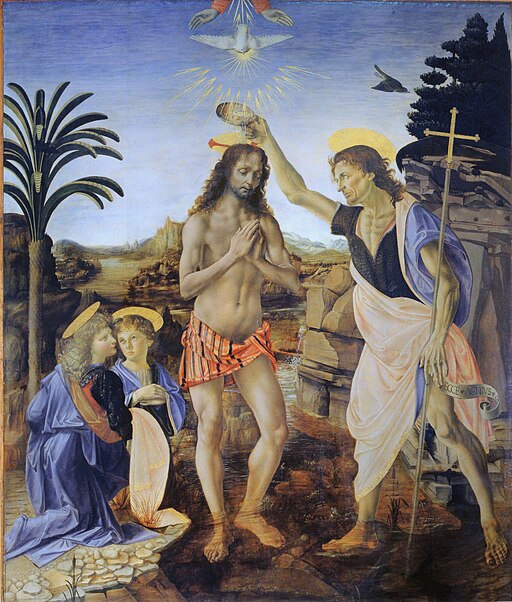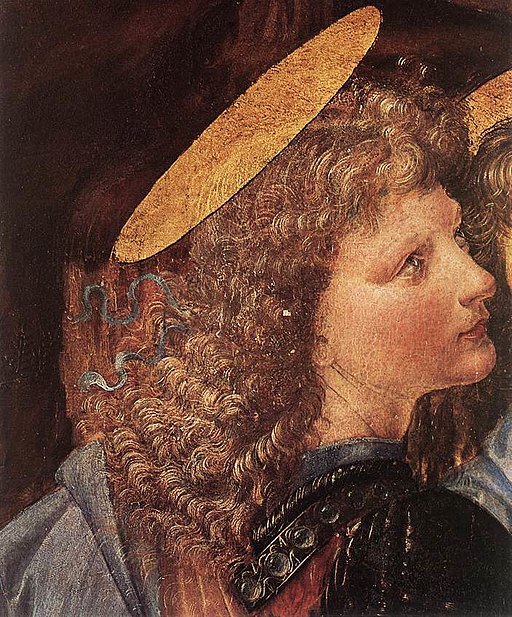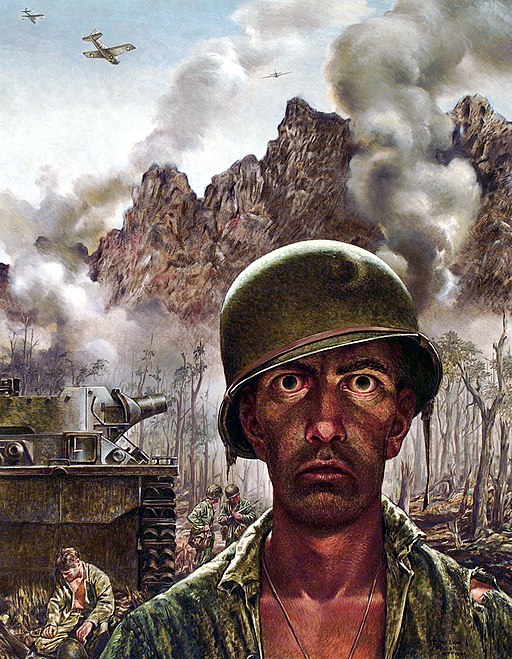
“The Baptism of Christ” by Verrocchio and Leonardo was painted in 1474–75. In this artwork, the Italian Renaissance painter Andrea del Verrocchio was assisted by his much younger apprentice Leonardo da Vinci.
Da Vinci was then a youth and an apprentice to Verrocchio’s workshop when he painted the angel on the left.
The gentle modeling of the left angel’s head and the fact that the paint at this point contains oil supports the general attribution of this section to Leonardo da Vinci.
Leonardo also painted much of the background landscape as it is portrayed in oil, like the angel, while the rest of the painting is in traditional tempera paint.
The technique of oil painting was introduced to Florence by Dutch and Flemish painters around the date that this painting was created.
According to an early biographer and historian, Verrocchio resolved never to touch the brush again because Leonardo, his pupil, had far surpassed him, but later critics consider this story apocryphal.
The image of John the Baptist is the portion of this painting that is most characteristic of Verrocchio’s style. The anatomical attention to bones, muscles, and tendons reflects Verrocchio’s interests, which he passed on to his pupils.
The head John the Baptist is rendered with the bones of the skull implied, and the beard reveals Verrocchio’s naturalistic interests.
This painting depicts the Baptism of Jesus by John the Baptist, as recorded in the Biblical Gospels. The composition shows St John the Baptist baptizing Jesus by pouring water over his head. The two angels on the riverbank are holding Jesus’ garments.
The extended arms of God, the golden rays, the dove with outstretched wings, and the cruciform nimbus show that Jesus is the Son of God and part of the Trinity.
The Gospel of Luke mentions the Spirit of God descending in the shape of a dove. Although a variety of symbols were attached to doves at the time the gospels were written, the dove imagery has become a well-known symbol for the Holy Spirit in Christian art.
Depictions of the baptismal scene typically show the sky opening and the Holy Spirit descending like a dove towards Jesus.
Da Vinci’s hand in this painting has generated much comment and mythology. This work was discussed in Giorgio Vasari’s “Lives of the Painters” in the biographies of both Verrocchio and Leonardo da Vinci Starting as early as the 16th century,
Andrea del Verrocchio was a sculptor, goldsmith, and painter who ran a large and successful workshop in Florence in the second half of the 15th century.
Verrocchio was not himself a prolific painter, and very few pictures are attributed to his hand, his fame lying chiefly in his sculptured works.
Verrocchio’s paintings, as are typical of Florentine works of that date, are in tempera on wooden panel.
The painting was commissioned by the Church of S. Salvi and was later transferred to the Vallombrosan Sisterhood in Santa Verdiana.
In 1810 it entered the collection of the Accademia and passed to the Uffizi in 1959.

Painted in oil paints by the young apprentice Leonardo da Vinci
Andrea Verrocchio
Andrea Verrocchio (1435–1488) was an Italian painter, sculptor, and goldsmith who was a master of an influential workshop in Florence. Few paintings are attributed to him with certainty, but several important painters were trained at his studio.
His pupils included Leonardo da Vinci, Pietro Perugino, and Lorenzo di Credi. His highest importance was as a sculptor, and his last work, the Equestrian statue of Bartolomeo Colleoni in Venice, is generally accepted as a masterpiece.
Botticelli also visited or worked in Verrocchio’s studio, and a Florentine poet wrote that:
“Whatever painters have that is good, they drank from Verrocchio’s spring.”
Leonardo da Vinci
Leonardo da Vinci was an Italian painter, draftsman, sculptor, architect, scientist, and an engineer who was already famous in his lifetime and is today considered a genius.
Leonardo’s masterpiece had considerable influence during his lifetime and continued to influence and attract lovers of history and art in our life.
Historians regard Leonardo as the prime example of the “Universal Genius” or “Renaissance Man.” An individual of unsatisfied curiosity and creative imagination.
He considered one of the most diversely talented individuals ever to have lived.
Leonardo was born out of wedlock to notary Piero da Vinci and a peasant woman named Caterina in Vinci in the region of Florence.
He was educated in the studio of Florentine painter Andrea del Verrocchio. Much of his earlier working life was spent in the service of Ludovico il Moro in Milan.
He later worked in Rome, Bologna, and Venice, and he spent his last years in France at a home awarded to him by Francis I of France.
Baptism of Jesus
The baptism of Jesus by John the Baptist is a significant event in the life of Jesus. It is described in three of the gospel and is considered to have taken place at Al-Maghtas, located in Jordan.
Most modern theologians view the baptism of Jesus by John the Baptist as a historical event. Along with the crucifixion of Jesus, most biblical scholars view it as one of the two historically specific facts about him.
Most Christian denominations view the baptism of Jesus as an important event and a basis for the Christian rite of baptism.
The existence of John the Baptist within the same time frame as Jesus, and his eventual execution is attested to by 1st-century historian Flavius Josephus, and the overwhelming majority of modern scholars view Josephus’ accounts of the activities of John the Baptist as authentic.
The Baptism of Christ
- Title: The Baptism of Christ
- Italian: Battesimo di Cristo
- Artist: Andrea Verrocchio
- Artist: Leonardo da Vinci
- Date: 1474 – 1475
- Periods: Italian Renaissance
- Media: oil and tempera on panel
- Dimensions: Height: 180 cm (70.8 in); Width: 152 cm (59.8 in)
- Museum: Uffizi Gallery, Florence
Leonardo da Vinci
- Name: Leonardo di ser Piero da Vinci
- Born: 1452 – Vinci, Republic of Florence (present-day Italy)
- Died: 1519 (aged 67) – Amboise, Kingdom of France
- Movement: High Renaissance
- Masterpieces:
- Mona Lisa
- The Last Supper
- Ginevra de’ Benci
- The Virgin and Child with St. Anne
- Virgin of the Rocks(The National Gallery, London)
- Virgin of the Rocks (Louvre, Paris)
- Madonna Litta
- Madonna of the Carnation
- Lady with an Ermine
- La belle ferronnière
- St John the Baptist
- Copies or from Workshop of Leonardo da Vinci
- The Battle of Anghiari – Copy of Leonardo da Vinci’s Lost Painting
- “Leda and the Swan” by Cesare da Sesto, after Leonardo da Vinci
- “Leda and the Swan” after Leonardo da Vinci, Attributed to Il Sodoma
- “Leda and the Swan” by Francesco Melzi, after Leonardo da Vinci
- “Virgin and Child with Young St John the Baptist” by Workshop of Leonardo da Vinci
- “The Baptism of Christ” by Verrocchio and Leonardo
Andrea del Verrocchio
- Name: Andrea del Verrocchio
- Born: 1435, Florence, Republic of Florence
- Died: 1488 (aged 52–53), Venice, Republic of Venice
- Movement: Italian Renaissance
- Notable Works:
- “The Baptism of Christ” by Verrocchio and Leonardo
“The Baptism of Christ” by Verrocchio and Leonardo
The Baptism of Christ – Andrea del Verrocchio
A Virtual Tour of the Uffizi Gallery
- “The Birth of Venus” by Sandro Botticelli
- “Primavera” by Sandro Botticelli
- Venus de’ Medici
- “The Battle of San Romano” by Paolo Uccello
- “Adoration of the Magi” by Botticelli
- “Judith Slaying Holofernes” by Artemisia Gentileschi
- Self-Portrait by Lucas Cranach, the Elder
- Self-Portrait by Hans Holbein the Younger
- Doni Tondo by Michelangelo
- “Susanna and the Elders” by Lorenzo Lotto
- Self-Portrait by Lawrence Alma-Tadema
- “Leda and the Swan” by Francesco Melzi, after Leonardo da Vinci
- “Pallas and the Centaur” by Sandro Botticelli
- Boy with Thorn
- “Self-portrait” by William Holman Hunt
- “The Baptism of Christ” by Verrocchio and Leonardo
Verrocchio and Leonardo
~~~
“Simplicity is the ultimate sophistication.”
– Leonardo da Vinci
~~~
Photo Credit 1) Andrea Verrocchio / Public domain
Popular this Week








 Sponsor your Favorite Page
Sponsor your Favorite Page SEARCH Search for: Search Follow UsJoin – The JOM Membership Program
Sponsor a Masterpiece with YOUR NAME CHOICE for $5
Share this:
- Tweet
